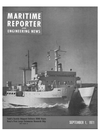
Page 31: of Maritime Reporter Magazine (September 1971)
Read this page in Pdf, Flash or Html5 edition of September 1971 Maritime Reporter Magazine
NYC Fire Department Contract
To M. Rosenblatt & Son, Inc.
M. Rosenblatt & Son, Inc. has received a contract from the New York City Fire De- partment to prepare contract plans and speci- fications for rehabilitation and modernization of the fireboat John J. Harvey and the tender
Smoke II.
Under the modernization program, the sil- houette of the Harvey will be lowered to per- mit the fireboat to reach the upper Harlem
River without experiencing the present delays caused by required drawbridge openings. Also under the program, the Smoke II will be re- engined for greater speed and provided with substantially improved firefighting capabilities by the installation of fire monitors and two 1,000-gpm pumps.
Interocean Trading Named
Japanese Distributor For
Arnessen Chipping Hammers
Corrosion Dynamics, Inc., of Roselle, N.J., manufacturers of the well-known line of Ar- nessen chipping hammers and production deck scalers, has announced the appointment of In- terocean Trading Co., Ltd., Tokyo, Japan, as their distributor for Japan.
According to Kenneth Westphal, vice presi- dent of Corrosion Dynamics, Interocean Trad- ing Co. will stock a complete line of chipping hammers and deck scalers, as well as a full spare parts inventory for fast shipment throughout the Far East area.
Further information may be obtained direct- ly from Interocean Trading Co., Ltd., Kyosho
Building, 9-3 Hirakawa-Cho, 1 Ghome, Chiyo- da-Ku, Tokyo 102, Japan, or in the United
States from Corrosion Dynamics, Inc., 1100
Walnut Street, Roselle, N.J. 07203.
Telemetry Used To Measure
Stresses In Main Gears
By using compact miniaturized transmitting and receiving equipment, the Technical In- vestigation Department of Lloyd's Register is now able to take measurements of stresses in moving machinery parts which, by reason of their high speed or inaccessibility, have hither- to precluded the use of slip rings and brush gear for taking off strain gage or other trans- ducer readings.
A recent example of this technique was pro- vided during investigations into failures of re- duction gearing on an oil tanker. There had been a previous failure of the main gear wheel rim, and measurements of axial vibration and shaft alignment taken at the time were not conclusive in establishing the cause of failure, so a more definite method of assessing gear tooth load distribution was needed.
For this purpose, very short base electrical resistance type strain gages were affixed to gear teeth on the main gear wheel. The gages were located at the forward and aft ends of the face width, in the tooth root radii at expected positions of maximum tensile stress due to bending. Each gage functioned as either an active or temperature compensating transducer as the teeth passed through the port and star- board meshes in turn.
Gages were also affixed to the forward and after faces of the rim in order to measure vari- ations in radical and circumferential strain when meshing. Power was supplied by high duty battery cells attached to the wheel. The strain gage signals from the rotating wheel were transmitted by a miniature transmitter fixed to the gear wheel and a wire wound aerial on the shaft journal, to a receiving head on the gear case.
For this particular investigation, convention- al methods of measurement were also used to collect information about other aspects of the system, including torque, axial vibration, pro- peller pitch, etc.
The findings supported the theory that con- centrated tooth loading could cause rim failure at the aft end of the gear mesh, and that the level of vibration in the system could lead to failure of the pinion support bearings, which would eventually allow misalignment to de- velop between the pinions and gear wheel. It also emerged that the cylinder combustion pressures could produce excessive torsional vi- bration if the variation from cylinder to cylin- der departed from agreed close tolerances, and that high vibratory torques were inflicted on rubber couplings when clutches were engaged or when the engines were running with un- even cylinder combustion pressures.
Modifications were suggested to overcome these faults, together with interim recom- mendations to make the system safe until the modifications could be implemented.
Remote controlled switching devices allow several measurements to be made on the same gear wheel without stopping the engine. Tele- metry has also proved to be an invaluable tech- nique for the investigation of stresses in tur- bine shaft systems, where the high peripheral speeds of the shaft surfaces and adverse ambi- ent conditions make the use of slip rings and brushes impracticable. Stresses in diesel en- gine crankshafts and other moving parts with- in the crankcase may also be more easily de- termined under full working conditions.
In the near future, it is intended to assess the running alignment of a propeller shaft sys- tem, using the telemetric equipment to meas- ure dynamic bending in the shafting, including that due to the propeller forces. unmatched experience
Antbot/
DRY DOCK COMPANY (FOOT OF COMMERCE ST. PERTH AMBOY, N. J.
Night or Day Telephone: 201-826-5000
Founded 1887
SINCE 1887
THE FINEST
REPAIRS
IN LESS TIME 3 Floating Dry Docks — Capacity to 5,560 Tons
Diesel Lighter — Capacity 50 Tons
Complete Machine, Electrical,
Carpenter, Boiler,
Shipfitting and Hull Departments
Fast 24 Hour Service
Voyage Repairs a Specialty
Less Than 3 Miles From Seven
Major Oil Terminals
Steel Fabrication — Rudders and Stern Frames
September 1, 1971 33

 30
30

 32
32
